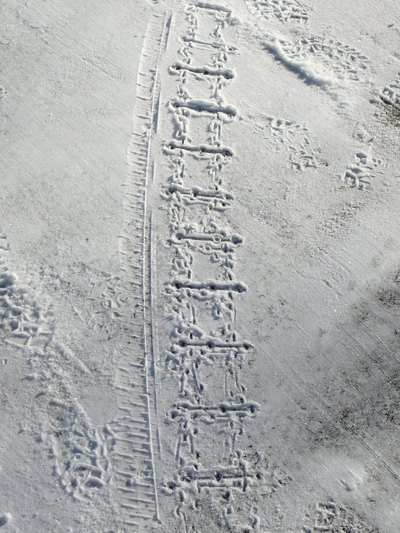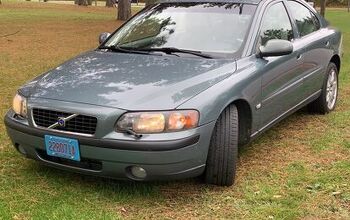Spike-Spider Winter Traction Package Review
I learned to drive in Philly in the winter. Although we were always warned to watch out for the dreaded black ice, the roads where I lived were plowed, salted and gently hilled. So there was little winter drama. The only slip sliding away in my ‘hood: Paul Simon’s doleful tune and the snow-covered mall parking lot where we went for late-night donuts. Flash forward to the winter of ‘07: a family vacation to the mountains of North Carolina in our rear drive Cadillac SRX. Before embarking, I glimpsed a warning on our cabin rental website: “four wheel-drive is a must.” Ch-ch-chains. Chains for fools. Or not.
Reviewing the Caddy's manual on the subject of winter traction devices advised me these automotive accoutrements had to come in the form of “s” class chains. The stricture is down to the SRX' passenger car roots; most “normal” cars can only accommodate s-chains in the [relatively] small spacing between the wheel and the body. So I started researching the “other” s-class.
I learned there are three sub-categories of s-class chains. For under $125, you get your basic metal chain with complicated installation and manual tightening. In the $125 to $250 bracket, your money buys you more sophisticated chains with mounting tools and semi-automatic self tightening links. Finally, as befits an SRX, one can buy the Cadillac of chains: the $450 Spike-Spiders.
As an incorrigible Scrooge, I never would have paid this much money for chains, even if they were fashioned from gold. But my wife, who found these arachnid glorifying chains online, insisted. A week before the trip, we purchased them from the U.S. distributor at www.spikes-spider.com. The large box that arrived soon thereafter contained the "chains," the mounting plate and an enormous collection of nuts, bolts, spacers and clips.
The instructions were a bit confusing and over-complicated. Yes sir, I’m here to tell you that there were not one but TWO– count ‘em TWO– separate methods for mounting the plate.
At first, the instrux seemed to imply that all of the car’s lug nuts would have to be removed. After a bit of re-caffeination, I divined it was only three. I proceeded to mount the plate to each rear wheel. Deploying the handy dandy measuring tool included with my purchase, it appeared that my SRX’s didn’t need no stinkin’ spacers. So I boxed up the extras, put the chains in the carry bag (included) and slapped on the decorative cover.
We arrived in a snow-free North Caroline on the last Sunday of 2007. Our driveway was so steep it could have served as a V2 launch pad. I knew if it snowed we were in big trouble. Or, as I preferred to think of it, I’d have the perfect opportunity to justify my wife’s heinous expenditure.
Lo and behold, three days later, two plus inches of the white stuff fell upon the hills. I was ready to test the Spike-Spiders.
Despite following the instructions for measuring the spacers, I was 1.5” short. I called the company on the cell, hot breath steaming in the cold mountain air. Spike-Spider immediately blamed me for not testing the mounting before the trip. Only after I gave the company my FedEx number– MY FedEx number– did they agree to send me extra spacers.
Stuck in the cabin, I watched my neighbors struggle with cheap chains. First, they tried the rear wheels and promptly wrapped them around the axle. I advised them that their car was propelled by the front wheels. An hour or so later they were off, dashing through the snow.
The new spacers arrived late Thursday– on a chainless FedEx truck. After remounting the plate, I installed the Spike-Spiders. I laid them over the wheel, twisted on the mounting bracket and voila! They automatically locked on as I drove.
Once down the mountain and onto the main paved road, I stopped, took off the mounting bracket, pulled off the Spiders, drove three feet and put them back in the bag. I could easily mount or dismount them in the time it takes to drum your fingers during a long red light.
Of course, the real test is how they performed as snow chains. The Spike-Spiders were extremely effective. The Swiss-made contraptions bit well on the snow and ice. In fact, in test panic stops, the SRX came to a halt nearly as well as it does on dry pavement. We climbed steep hills without slipping, with better control than the four wheel-drive vehicle we followed up one particularly steep snowy road.
When properly installed, the Spike-Spiders are a well-designed product that provide an effective solution for tough winter driving. The only negatives are the price, the lame-ass instructions, and the major geek factor the mounting plates project. Otherwise, you're good to snow.
[German language Spike-Spider video here .]
More by Michael Posner
Latest Car Reviews
Read moreLatest Product Reviews
Read moreRecent Comments
- Lorenzo The Renaissance Center was spearheaded by Henry Ford II to revitalize the Detroit waterfront. The round towers were a huge mistake, with inefficient floorplans. The space is largely unusable, and rental agents were having trouble renting it out.GM didn't know that, or do research, when they bought it. They just wanted to steal thunder from Ford by making it their new headquarters. Since they now own it, GM will need to tear down the "silver silos" as un-rentable, and take a financial bath.Somewhere, the ghost of Alfred P. Sloan is weeping.
- MrIcky I live in a desert- you can run sand in anything if you drop enough pressure. The bigger issue is cutting your sidewalls on sharp rocks. Im running 35x11.5r17 nittos, they're fine. I wouldn't mind trying the 255/85r17 Mickey Thompsons next time around, maybe the Toyo AT3s since they're 3peak. I like 'em skinny.
- Adam4562 I had summer tires once , I hit a pothole the wrong way and got a flat tire. Summer tires aren’t as durable as all season , especially up in the northeast . They are great of u live in Florida or down south . I have all season tires which are on my Subaru which is awd. My mom has a car so she switches from all season to snow tires . I guess depends on the situation
- MaintenanceCosts I hope they make it. The R1 series are a genuinely innovative, appealing product, and the smaller ones look that way too from the early information.
- MaintenanceCosts Me commenting on this topic would be exactly as well-informed as many of our overcaffeinated BEV comments, so I'll just sit here and watch.




































Comments
Join the conversation
[...] Spike-Spider Winter Traction Package Review | The Truth About CarsTTAC’s Michael Posner reviews the Spike-Spider winter traction package. … A week before the trip, we purchased them from the U.S. distributor at www.spikes-spider.com. The large box that arrived soon thereafter contained the "chains," the mounting plate and an enormous collection of nuts, bolts, spacers and clips. [...]